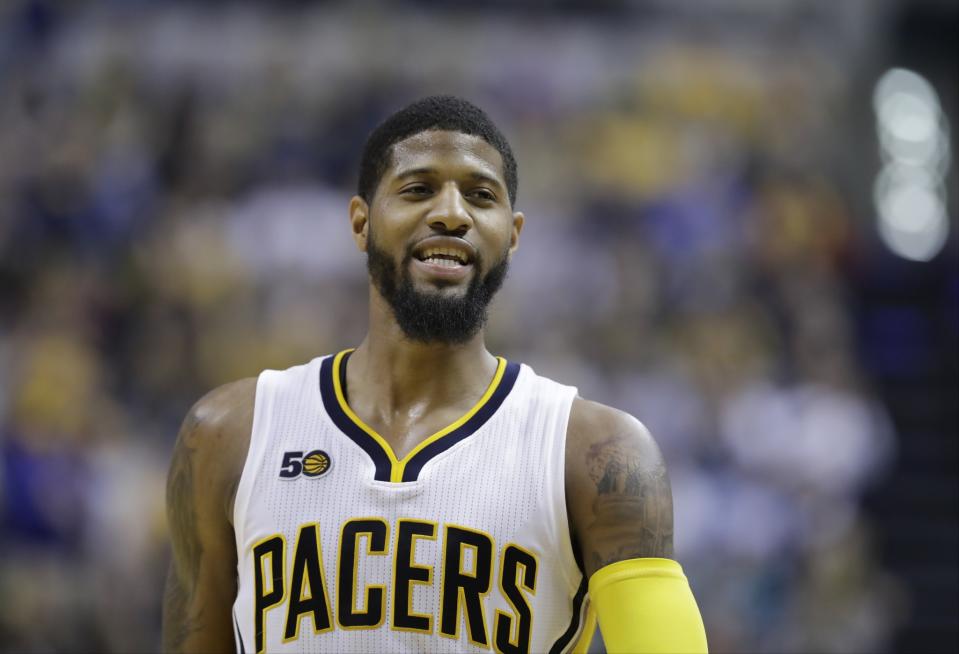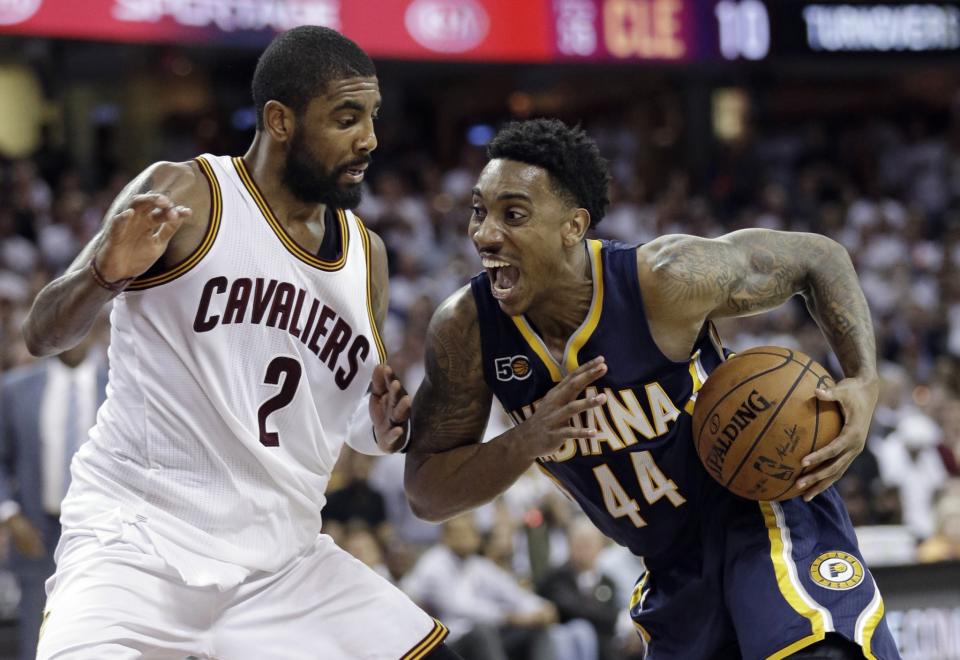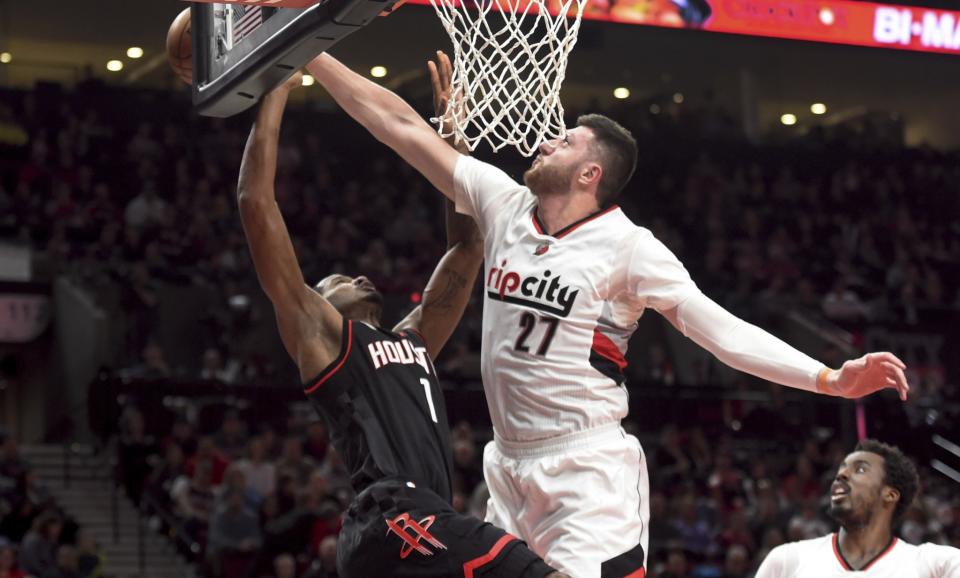Summer agenda: How will Pacers deal with Paul George?
The Vertical Front-Office Insider Bobby Marks, a former 20-year executive with the Nets, looks at the possible offseason plans and roster details for every team in the league.
Previous teams in the series: Nets and Suns | Timberwolves and 76ers | Magic and Kings | Hornets and Pelicans | Knicks and Nuggets | Lakers and Heat | Mavericks and Pistons
INDIANA PACERS
Offseason focus
The Paul George timeline
The change in power from outgoing president Larry Bird to general manager Kevin Pritchard does not shift the focus when it comes to Paul George.
The Pacers are entering a critical juncture in how they’ll deal with the soon-to-be-expiring contract of George.
Here are the Pacers’ options:
1. Extend him if he earns All-NBA honors.
2. Renegotiate his current contract to represent a Tier 2 max player.
3. Explore the trade market if he declines the first two options.
4. Re-sign free agents Jeff Teague and C.J. Miles, play out the season and explore the trade market for George to improve the roster.
Pritchard and his management team will need to meet with George’s agent, Aaron Mintz, to get a better understanding of what George wants.
The meeting should resemble a recruiting pitch to a free agent in July.
George likely will focus on the Pacers’ plan to improve now and in the future.
If George earns All-NBA honors, he will be eligible to sign a five-year, $207 million extension that starts in 2018-19. George would need to amend his contract to eliminate his player option in 2018-19.
Not earning All-NBA honors would allow the Pacers to extend his contract for four years (starting in 2018-19) with only a 120 percent salary increase, but that isn’t a realistic scenario.
Without an extension, Indiana could go the direction Oklahoma City did with Russell Westbrook last summer and renegotiate George’s current contract.
To do so the Pacers would need to create cap space, which is currently unavailable because of the free-agent cap holds of Teague and Miles.
Without a commitment, the Pacers will need to test the trade market or trust their instincts and relationship with George and hope the All-Star will commit in 2018.
One thing is for sure: By July 1, Pacers management will need to have a plan in place.
Long-term commitment to Teague
George’s status should not impact the Pacers’ decision on Teague.
While Miles should be a priority, Teague is a necessity.
The cost, however, could be substantial.
Teams value Teague’s durability and the well-managed minutes (career average of 27 per game) he’s played in his eight-year career.
The market for Teague will be affected by the marquee free-agent point guards likely remaining with their current teams.
The non-guaranteed contracts
Indiana has six players who have a team option or non-guaranteed contract for next season.
Five of them – Lavoy Allen, Joe Young, Rakeem Christmas, Georges Niang and Glenn Robinson Jr. – have a late June trigger date or a July 1 deadline for the Pacers to guarantee the contract.
Kevin Seraphin’s contract does not become guaranteed until Aug. 1.
The decisions will come down to player development and impact, the potential need for roster spots and possibly needing cap space for a George renegotiation.
SUMMER CAP BREAKDOWN
Guaranteed 2017-18 Insider info
Paul George $19,508,958 Extension and renegotiation eligible
Thaddeus Young $14,996,348 Extension eligible
Monta Ellis $11,227,000 Extension eligible
Al Jefferson $9,769,821
Lance Stephenson $4,180,000
Myles Turner $2,569,920
Non/partial 2017-18 Guarantee date
Lavoy Allen $4,000,000 Team option June 23
Kevin Seraphin $1,974,159 Aug. 1
Joe Young $1,471,382 July 1
Rakeem Christmas $1,471,382 July 1
Glenn Robinson III $1,471,382 July 1
Georges Niang $1,312,611
FA cap hold 2017-18 FA status
Jeff Teague $13,200,000 Bird
C.J. Miles $8,708,555 Bird/expected to opt out
Aaron Brooks $3,240,000 Non-Bird
First-round cap hold 2017-18
No. 18 $2,028,360
Salary table 2017
Guaranteed salaries $62,402,047
Non-guaranteed $11,550,916
Free-agent cap holds $27,176,915
Salaries: cap $101,129,878
Salaries: tax $73,952,963
Salary cap $101,000,000
Luxury tax $121,000,000
Cap space None ($129,878 over)
Tax room $47,047,037
Projected cap space
The free-agent cap holds of Teague and Miles are worth $21 million and have the Pacers right at the salary cap.
Until there are resolutions, the Pacers will not have cap space.
Indiana does have $11.5 million in non-guaranteed contracts to create room or open a roster spot.
However, because the Pacers have the $8.4 million and $3.2 million exceptions, creating room at the expense of the players on non-guaranteed contracts does not benefit Indiana.
June draft picks
Indiana has its own first-round pick at No. 18 and also the No. 47 pick in the second round.
Future draft picks
The Pacers own their future first-round picks.
PORTLAND TRAIL BLAZERS
Offseason focus
Free agency begins in June
The Trail Blazers’ cap situation forces them to put a premium on the draft.
Because Portland used cap space to sign free agents last summer, restrictions leave Portland with only the minimum and $5.2 million tax exceptions to use.
Portland has $131 million in guaranteed contracts heading into next season, and improvement starts with the draft and will continue through player development and value signings in free agency.
Portland has three draft picks – Nos. 15, 20 and 26 – that should provide help.
Re-evaluate last summer’s restricted free agents
It’s tough to question the decisions to match the offer sheet for Allen Crabbe last summer and re-sign Maurice Harkless and Meyers Leonard.
Lose all three players – or in the case of Crabbe not match the Nets’ offer sheet – and Portland would not have the cap space to replace each one.
The key in restricted free agency is to overpay with an eye on future value and use the player as part of the rotation or as a trade chip in the future.
Now a year later and facing the luxury tax, general manager Neil Olshey will need to decide if last summer’s assets are expendable or still have value to the Blazers, even at a significant cost.
The luxury-tax threshold
The Trail Blazers will be a tax team, but what will the ultimate cost be?
Unlike this past season, when cap creativity had the Trail Blazers $4,000 below the tax, Portland is not likely to find such good fortune next season.
The Trail Blazers’ salaries this summer project to be $141 million with an additional $45 million in luxury taxes.
Portland has the season to reduce salaries and tax, or be content with the current roster.
The good news is the returning roster does not feature an aging core and should improve.
The Trail Blazers return 12 guaranteed contracts on the youngest roster in the league.
Holding pattern with Jusuf Nurkic
Acquiring Jusuf Nurkic in an early February trade accomplished multiple goals.
For starters, the trade allowed Portland to stay under the luxury tax.
The deal also changed the identity of the team by adding a low-post presence, which helped the Blazers springboard to a 17-8 finish and a playoff berth.
The trade also bought the Trail Blazers time when it came to free agency.
Instead of contract negotiations this summer with Mason Plumlee and the possibility of substantial cost both in salary and luxury taxes, Portland can wait until 2018 to re-sign Nurkic.
Nurkic is rookie-extension eligible but holding off extension talks until there is a clear path to reduce salary in 2018 should be the priority.
Keeping the roster in tact for 2018 with a new contract for Nurkic would see the Trail Blazers’ salaries balloon to $160 million-plus and $100 million-plus in luxury tax.
Summer cap breakdown
Guaranteed 2017-18 Insider info
Damian Lillard $26,153,057
C.J. McCollum $23,962,572
Allen Crabbe $19,332,500 Trade bonus
Evan Turner $17,131,148
Meyers Leonard $9,904,494
Maurice Harkless $10,162,921
Al-Farouq Aminu $7,319,035 Extension eligible
Ed Davis $6,352,531 Extension eligible
Noah Vonleh $3,505,233
Jusuf Nurkic $2,947,305 Rookie extension eligible
Shabazz Napier $2,361,360 Rookie extension eligible
Jake Layman $1,312,611
Non/partial 2017-18 Guarantee date
Festus Ezeli $7,733,000 $1 million guaranteed June 30
Pat Connaughton $1,471,382 July 25
Tim Quarterman $1,312,611
First-round cap holds 2017-18
No. 15 $2,365,560
No. 20 $1,859,400
No. 26 $1,465,920
Dead cap space 2017-18
Anderson Varejao $1,984,005
Salary table 2017
Guaranteed salaries $131,444,767
Dead money $1,984,005
Non-guaranteed $9,516,993
Tax variance $158,771
Free-agent cap holds $5,690,880
Salaries: cap $148,636,645
Salaries: tax $143,104,536
Salary cap $101,000,000
Luxury tax $121,000,000
Cap space None ($47,636,645 over)
Tax room None ($22,104,536 over)
Projected cap space
The Trail Blazers are shifting focus from a team under the salary cap last summer to one that is now over the luxury tax.
The Trail Blazers do have the $5.2 million tax mid-level exception.
June draft picks
Portland has three first-round picks.
Besides their own, the Trail Blazers have the Cavaliers’ and Grizzlies’ selections.
The Cleveland pick was acquired last season in the Anderson Varejao trade and was amended (changed from 2018 to 2017) as part of the Kyle Korver trade this past January.
The Grizzlies’ pick was acquired from Denver as part of the Mason Plumlee trade.
Portland does not have a second-round pick.
Future draft picks
Portland has its own future first-round picks.
Popular video from The Vertical:





